
For over 30 years now, getting my sticky little mitts on a BMW 7-Series has always been a special treat. Why?
Quite simply, it’s the Munich automaker’s technology flagship and you will normally see something new in a 7 before it filters down to the rest of the range such as the redesigned 5 Series launched earlier this year. Two items I recall are a jewel like, four litre petrol V8 in 1994, so smooth and refined the engineers had to ‘put back’ some traditional bent eight exhaust burble using a combination of electronics and exhaust vanes and the, perhaps less acclaimed, 2003 launch of the twist-and-push iDrive controller supposed to eliminate buttons and knobs which required something like 15 individual steps to store a radio station though, in fairness, for a first attempt, it did work quite well with many other functions.
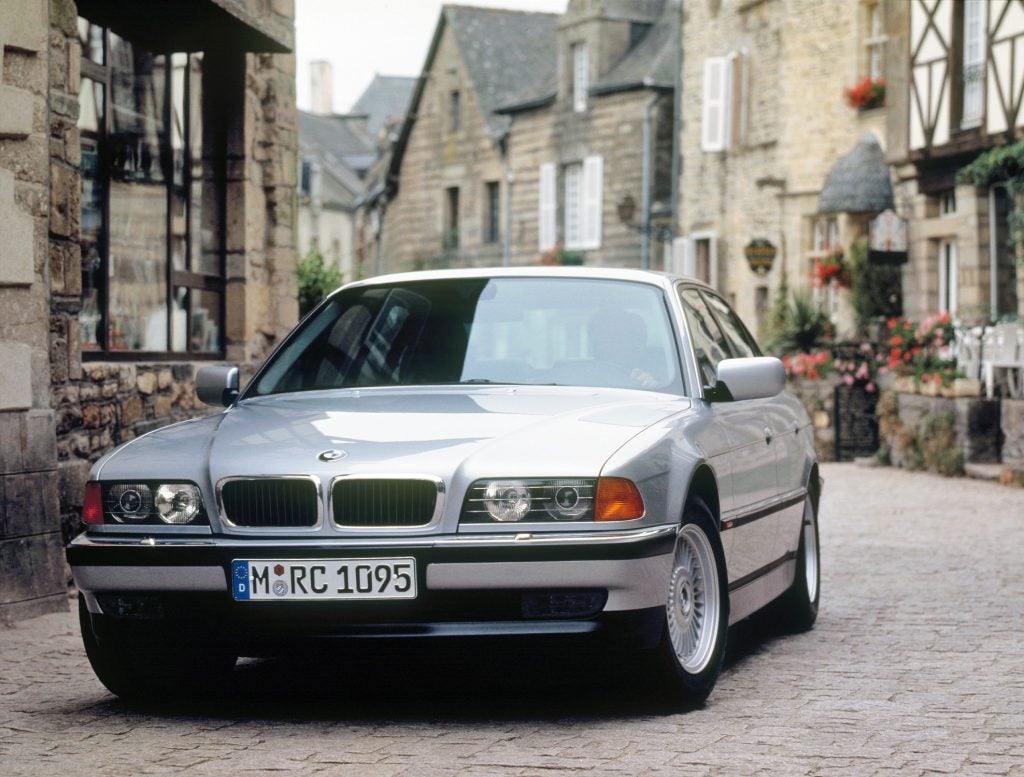
Clearly, this latest 7 – officially an i7 XDrive 60 battery electric vehicle (BEV) – had already gained a reputation which preceded its arrival on my driveway. “That’s the one with a movie screen in the back, isn’t it?” asked a delivery driver. Yup. As an option, the car comes with a full width HD screen folded up neatly against the roof in the rear compartment. Each door contains a small screen and buttons controlling climate, tv, radio, phone and blinds. Select TV and the screen purrs down into place, the sunroof shade glides shut and side and rear window blinds roll up. Only problem was, none of our devices or sole streaming service was compatible so we didn’t get to experience the feature properly. Nonetheless, it’s a great party trick to play on first time visitors to the rear seat, especially those who haven’t yet noticed the screen stashed neatly above.
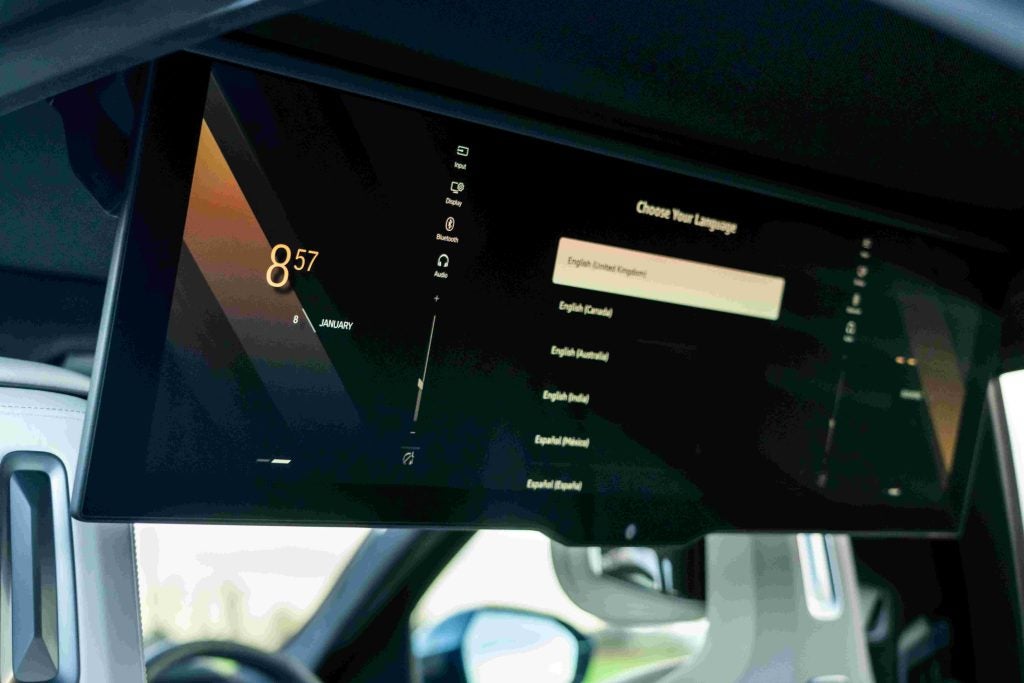
The Amazon Fire TV is a 31.3″ 8K touchscreen display with Bowers & Wilkins surround sound system (with optional in-seat exciters) and touch screen remotes in the door panels and, subject to subscription, passengers can watch content up to 4K/UHD from popular apps, stream videos, play games, listen to music, get information, and watch downloaded programmes. The screen can be moved closer or further from the rear passengers to put it within arm’s reach for touch controls or to manoeuvre it to the preferred viewing distance. Audio can be heard through the speakers or by connecting up to two pairs of Bluetooth headphones with independent volume controls. The screen is revealed to the accompaniment of the latest sound composition created for BMW by film score composer Hans Zimmer.
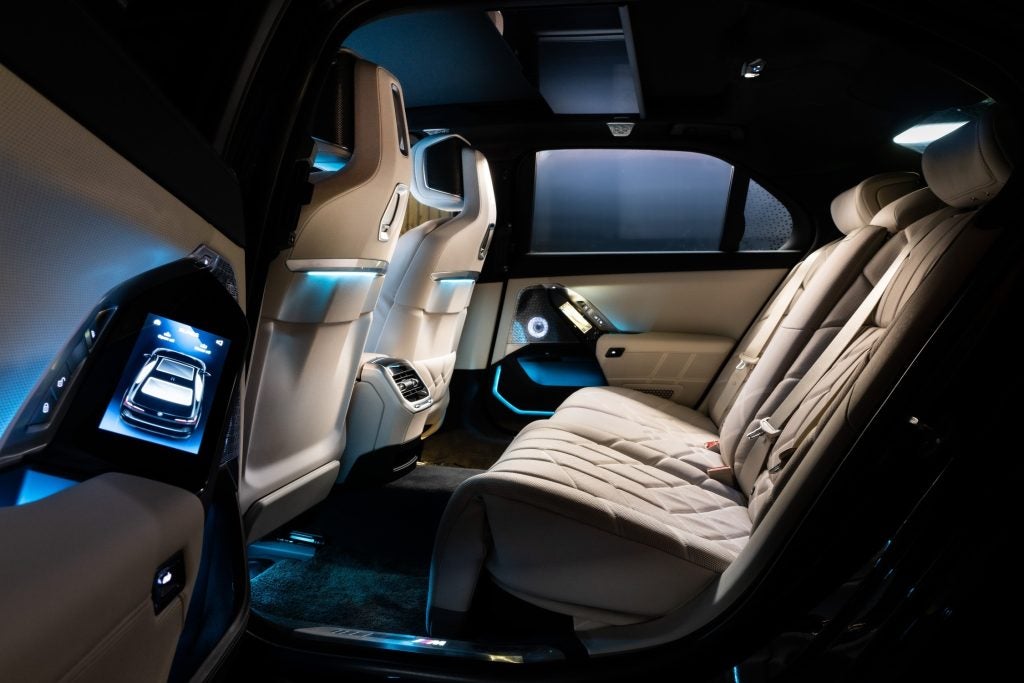
Rocket launcher
The other party trick is to demonstrate the extraordinary acceleration of this very powerful EV. As with a number of other cars, various driving modes can be selected and each mode pre-selects various factors such as steering and accelerator responses and interior ambient lighting. The BMW flagship has several modes and selecting Sport changes the cabin lighting to red and tightens the front seat back side support and so on. Then you floor it from rest and the G-forces can actually be felt to the surprise and delight of first time riders. And you can do that within a street legal 30mph UK urban limit having first, of course, checked surroundings to ensure such blast-off can be done safely.

US Tariffs are shifting - will you react or anticipate?
Don’t let policy changes catch you off guard. Stay proactive with real-time data and expert analysis.
By GlobalDataDrivetrain
The i7 xDrive60 has fifth generation (already?) eDrive technology comprising integrated drive units at the front and rear axles that combine the electric motor, power electronics and transmission within a single, very compact housing plus charging technology and high voltage battery. Compared with the iX and i4, the charging software has undergone further improvement, the temperature of the high voltage battery is controlled more precisely and there is also an innovative facility for saving charging profiles. The navigation system displays the charging-optimised route more quickly and in even greater detail.
The use of rare earth metals is avoided altogether in the manufacture of the motor rotor. The motor driving the rear wheels generates peak output of 313hp while the unit at the front axle produces 258hp. The duo delivers a combined 544hp and torque of 745Nm. Hence the rocket launch from 0 to 62mph (100km/h) in 4.7 seconds.
The slim high voltage battery with cell height of 110mm is low down in the vehicle floor and provides 101.7kWh of usable energy. A heat in the integrated heating and cooling system for the cabin and drive system also helps boost efficiency as does that adaptive or individually adjustable recuperation feature. The battery is heated by a 5.5kW electric flow heater.
Adaptive recuperation
Adaptive recuperation from the iX and i4 has been further improved for the i7 and is now also able to take downhill sections and information from the traffic light recognition function into account. Adaptive recuperation generally allows the intensity of brake energy regeneration during overrun and braking to be automatically optimised for the road situation, as detected using data from the navigation system and the driver assistance systems’ sensors. When approaching a junction, for example, the level of recuperation can be increased even if route guidance isn’t activated – thereby feeding energy back into the high-voltage battery while harnessing the deceleration effect at the same time. On the open road, meanwhile, the coasting function can take over, allowing the car to ‘free wheel’ with no drive power whenever the driver eases off the accelerator. Energy is no longer supplied to the two electric motors in this state, meaning no battery power is consumed.
Better charging
Once the high voltage battery reaches a higher charge level, the new charging process aims to ensure the charging rate drops smoothly instead of following the previous stepped curve. This produces a more rounded charging curve overall, resulting in shorter charging times. Following an initial, temperature dependent phase of constant power supply, the new process now also controls charging based on a continuous nominal voltage curve that allows for the variables of temperature, recharged capacity and charge level at start of charging. The Combined Charging Unit allows AC charging at up to 11 kW while DC power can be used up to 195 kW. This allows 106 miles (WLTP) of range to be added in just 10 minutes at a high power charging station.
Automated charging settings
The can also store customised charging settings for multiple individual charging points. These settings are automatically used the next time the car returns to a charging point stored in the memory. Preheating of the high voltage battery can also now be started manually when approaching a high-power charging station without the navigation system’s route guidance function activated. Cloud based navigation calculates a charging optimised route as soon as the destination has been entered if the vehicle’s current range is not enough to reach the destination.
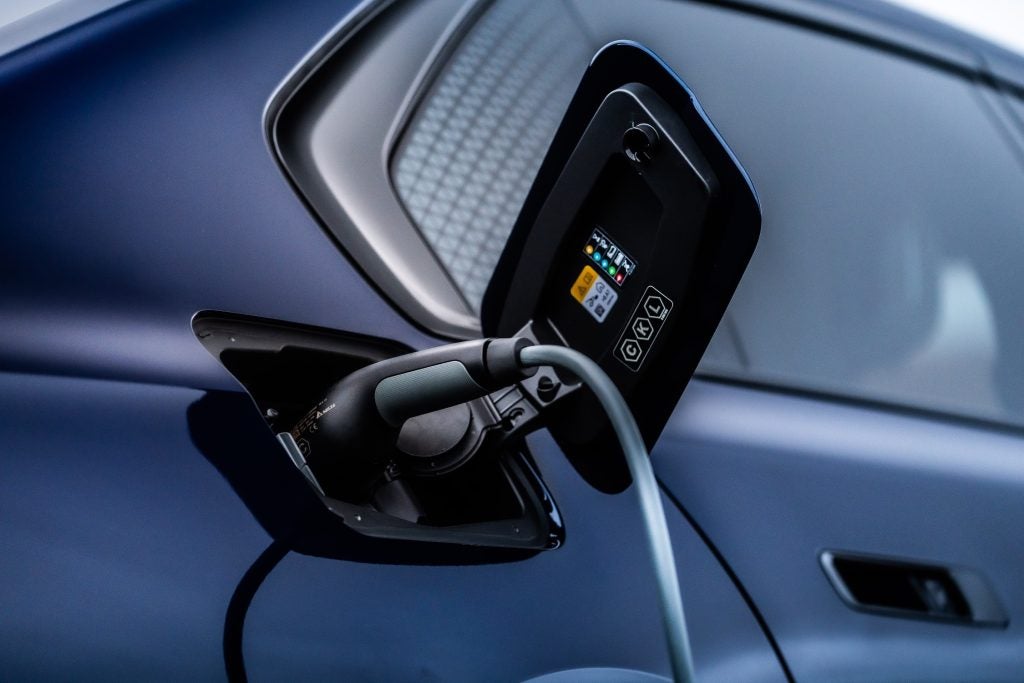
PHEVs, too
Two plug in hybrid versions are also offered: the 750e xDrive and M760e xDrive. These have a new eight speed Steptronic transmission, a 200hp permanently excited synchronous motor with power electronics and a six cylinder in line petrol engine and intelligent all wheel drive. The M760e produces 571hp and peak torque of 800Nm while the 750e develops 490hp and 700Nm.
Bigger, of course
This latest 7 Series grew 130mm in length to 5,391mm, by 48mm in width to 1,950mm and by 51mm in height to 1,544mm on a wheelbase 5mm longer at 3,215mm which was said to further enhance rear seat comfort. Headroom was also improved.
The car has adaptive LED Headlights including cornering light, plus matrix high beam and the Selective Beam non dazzling high beam assistant. But this is a BMW so, of course, there are optional headlights using Swarovski crystals arranged in L shapes and each backlit by 14 LED units acting as sidelights and daytime driving lights with the crystals reflecting light in a multitude of facets even when off. At night, 22 LED units light up the crystals from behind and team up with the kidney grille’s contour lighting to create an unmistakable light graphic. Two LED elements below the crystals provide a daytime driving light signature, integrate the turn indicator, and increase the sparkle of the crystals in each function and colour.
There’s also a Welcome and Goodbye Scenario. Approach the car and the illuminated surround of the kidney grille is activated followed by the enhanced sparkle of the crystal headlights. Then the standard-fit ‘dynamic light carpet’ is revealed. LED lights integrated into the door sills project four graphics, one after the other, onto the ground just outside the doors. This welcome display continues in the interior and is the sort of new tech the 7 has always been renowned for.
Glass cockpit
Digitalisation has reduced the number of buttons, switches and controls in the cockpit which features a curved display consisting of a 12.3-inch information display behind the steering wheel and a control display with a screen diagonal of 14.9 inches. Arranged beneath a shared glass surface, the displays are directed towards the driver.
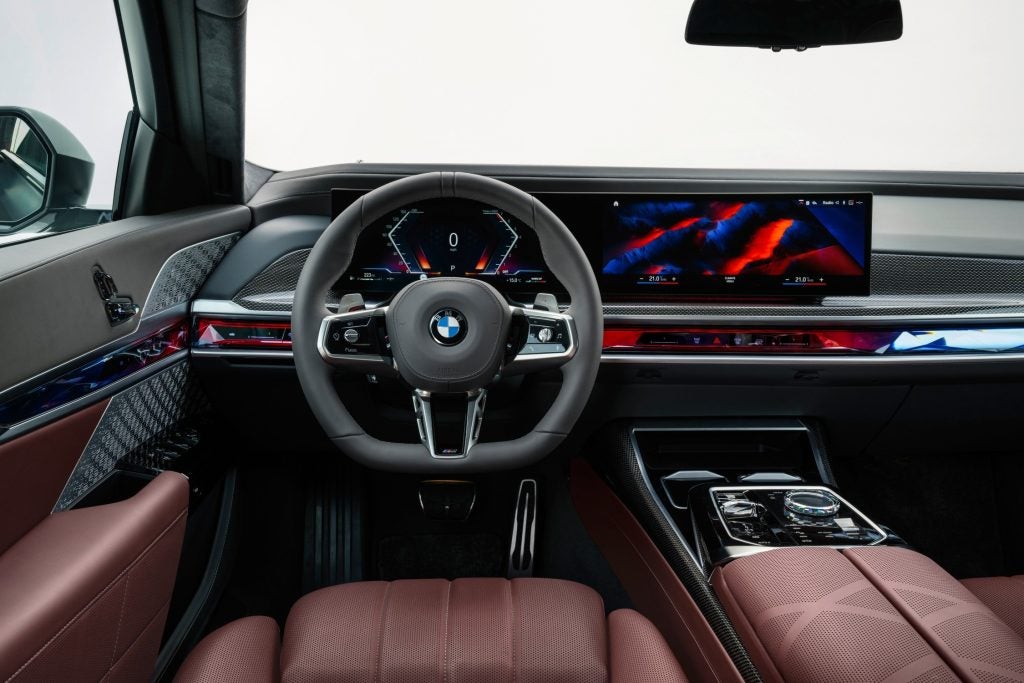
The Interaction Bar makes its debut in the 7 and houses touch-sensitive control panels for adjusting the ventilation and climate control, activating the hazard warning lights and opening the glove compartment. The lighting depends either on the My Mode setting selected or can be set as desired.
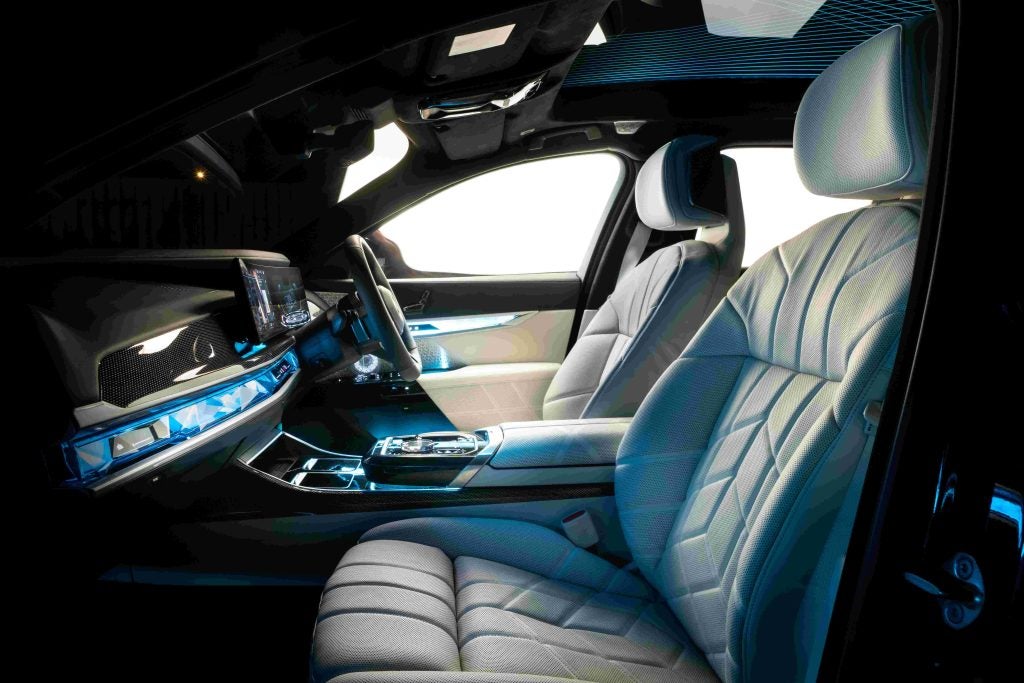
The bar combines function control, ambient lighting and the ability to adjust appearance while entry and exit are accompanied by a welcome/goodbye display. It also shows the driver and front passenger via the Safe Exit function when it is safe to get out. From the ambient lighting menu the driver can decide which events the bar reacts to with dynamic light animations such as incoming phone calls. The Intelligent Personal Assistant can also appear on the bar.
Seats
Multifunction seats are standard with electric adjustment, seat heating and lumbar support and are adjustable via door controls or a menu in the iDrive control/operation system. The optional Front Comfort Pack adds active seat ventilation with optimised cooling and a massage function with nine settings. The optional Travel & Comfort System includes things like mounts for attaching tablets. Multifunction seats, active seat ventilation and a massage function are also available for the rear compartment. The Executive Lounge option, part of the Executive Pack, includes a reclining function with integrated leg rest for the space behind the front passenger seat, plus an optional quilted and heated armrest with glass insert and integrated smartphone tray for inductive charging. There’s also adjustment of the backrest angle and backrest upper section angle, forward/back position and seat surface tilt plus leg rests and a heel rest extending out from the back of the front passenger seat.
Standard equipment includes four zone automatic climate control and, in place of conventional air vents, the instrument panel incorporates slot type outlets arranged along the full width of the interaction bar. It is now even possible to adjust the temperature in the front seat footwells separately. The i7 has a model specific climate control unit with a heat pump.
Glass sunroof with new light effects
That 90s 7 V8 could be ordered with a sliding metal sunroof opening above the front seats – 30 years on, a full length panoramic glass sunroof is standard with an electric sunshade. Order the Sky Lounge option and you get a light show using light threads backlit by LEDs. This replicates the quilt pattern on the seat surfaces. The glass construction consists of three individual layers of glass and a pattern within this emits the light effects which are also part of the Welcome Scenario and vary according to the driving mode selected.
Automatic doors
Automatic doors are another option. To open or close the doors, just touch the handles set flush into the body or buttons in the interaction bar at the front of the cabin or the rear door trim. Opening and closing can also be activated using the radio-operated key. Later, this will also be operated via the app from outside and by voice command or using iDrive while inside. Other tech includes a collision protection function which uses data from 12 ultrasound sensors on either side of the car and an obstruction alert when closing them.
The boot lid also has automatic opening and closing. It is activated by either the push of a button or the movement of a foot under the rear apron. The load capacity of the plug in hybrid models is 525 litres, an increase of 105 litres on the previous generation model. The boot of the BMW i7 has 500 litres of load space.
This really is a technology masterpiece and we only scratched the surface during a week’s loan. An owner likely will spend months discovering all the features and experimenting with the various settings.
And amazing first time riders.
See also: BMW and Innoviz achieve Level 3 autonomous driving with the 7 Series



